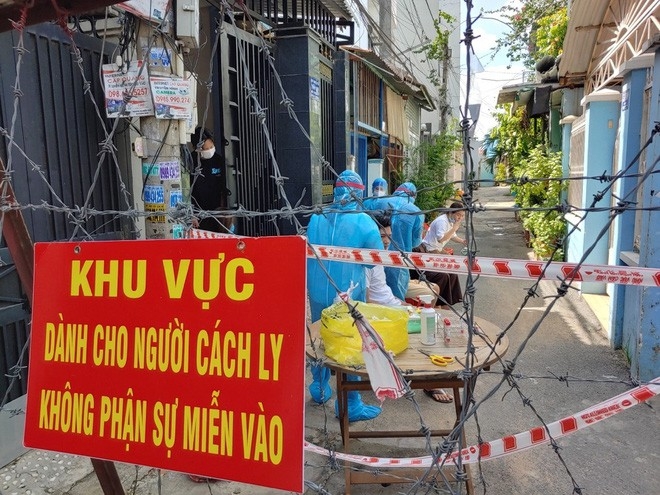Ho Chi Minh City officially piloted home quarantine for F0 cases
 |
| Quarantine areas must be equipped with notices with warning signs |
For asymptomatic cases of F0 patients being treated at hospital, if the RT-PCR test on day 10 is negative or still positive but with low viral load, they will be transferred to isolation at home. They will be required to take RT-PCR tests on days 14 and 21 at home.
These F0 cases must be monitored by local health authorities as well as observe safety measures in infection prevention and control.
Similarly, if F0 cases are medical staff, they will also stay home, self-monitor, and report their health status to the health monitoring agencies each day and perform tests as prescribed.
In high-risk areas, in case an F1 patient does not meet the criteria of the Ministry of Health for home isolation, they will be transferred to concentrated isolation and tested for RT-PCR on day 7 instead of day 14. If the result is negative, they will be transferred to isolation establishments.
For F1 cases in high-risk areas who are eligible for home isolation, their homes must have warning signs and fences. No members living in the house will be allowed to leave the building.
F1 cases must limit contact to those living within their household. It is better if each F1 case has a separate room. Besides, F1 cases must use separate personal belongings, meals, and trash cans. Toilets must be cleaned and disinfected after each use by an F1 patient.
In case there is an F0 case amongst F1 living in dormitories and apartment buildings, all F1s will have to undergo concentrated quarantine.
In case there are a large number of F1 cases staying in a blocked area such as a boarding house, dormitory, residential area, centralised medical isolation will be applied to the area. In case of high density, quarantined people have to go to concentrated isolation areas.
In low-risk areas, if all or some members living in the house are identified as F1, the isolation of these members at home does not require a separate isolation room for each member.
What the stars mean:
★ Poor ★ ★ Promising ★★★ Good ★★★★ Very good ★★★★★ Exceptional
Themes: Healthcare Platform
- Takeda Vietnam awarded for ongoing support of Vietnam’s sustainability efforts
- Self-care signals shift towards sustainable healthcare
- DKSH to acquire Vietnamese healthcare distributor Biomedic
- Two national hospitals expand capacity with new facilities
- Vietnam moves to enhance disease prevention, equity, and sustainability
Related Contents
Latest News
More News
- Vietnam moves to enhance disease prevention, equity, and sustainability (December 18, 2025 | 17:39)
- New ILO report offers policy recommendations for disability inclusion (December 04, 2025 | 15:18)
- Maternal job loss may affect children’s mental health, research shows (December 03, 2025 | 19:11)
- Women lead Vietnam’s shift to climate-resilient agriculture (December 03, 2025 | 19:10)
- Experts highlight unpaid care work as key barrier to gender equality (December 03, 2025 | 15:15)
- Opportunities and inequalities for women workers in Vietnam's garment industry (December 03, 2025 | 09:00)
- Vietjet flights carry love to devastated central region (November 28, 2025 | 11:35)
- New initiative to boost the fight against domestic violence (November 26, 2025 | 10:00)
- South Korea funds IOM relief for Vietnam’s typhoon-affected communities (November 24, 2025 | 15:33)
- AI and human-centred values set to shape the future of HR in Vietnam (November 21, 2025 | 18:04)

 Tag:
Tag:




















 Mobile Version
Mobile Version